This class will explore the actionable ways to honor, respect, and value Black people in your daily life.
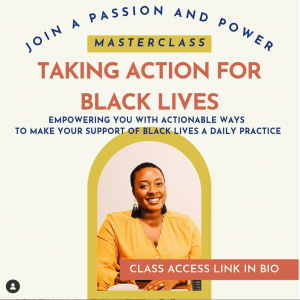 It’s Time To Make Your Support Of Black Lives A Daily Practice
It’s Time To Make Your Support Of Black Lives A Daily Practice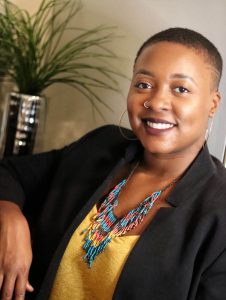 I’m on a mission to create a world rooted in equity, joy, and liberation and I firmly believe that each of us has the power to radically contribute to this vision of society. We are in the midst of a critical movement for social, economic, and racial justice and my goal is to help you activate change through practical daily action. As a criminologist turned public scholar and justice educator, I have helped hundreds of learners transform their understanding, practice, and commitment to justice.
I’m on a mission to create a world rooted in equity, joy, and liberation and I firmly believe that each of us has the power to radically contribute to this vision of society. We are in the midst of a critical movement for social, economic, and racial justice and my goal is to help you activate change through practical daily action. As a criminologist turned public scholar and justice educator, I have helped hundreds of learners transform their understanding, practice, and commitment to justice.
Recognizing the need to extend my work beyond the confines of academia’s ivory tower, I founded Passion and Power to empower change-driven people with the tools to effectively combat injustice through critical thinking and knowledge-based advocacy.
I know that to radically transform the way our justice system and communities achieve justice, we must first commit to changing ourselves. Together, we can activate advocacy together!
Happy Birthday, Fayard Antonio Nicholas! Born October 20, 1914.
Between him and his brother, Harold, Fayard Nicolas was the elder and more talkative brother. Tap dancing as a pair called the “Nicholas Brothers tap duo,” the boys wowed the world of tap dancing with astonishing athleticism, inspiring generations of dancers from Fred Astaire to Savion Glover to Mikhail Baryshnikov.
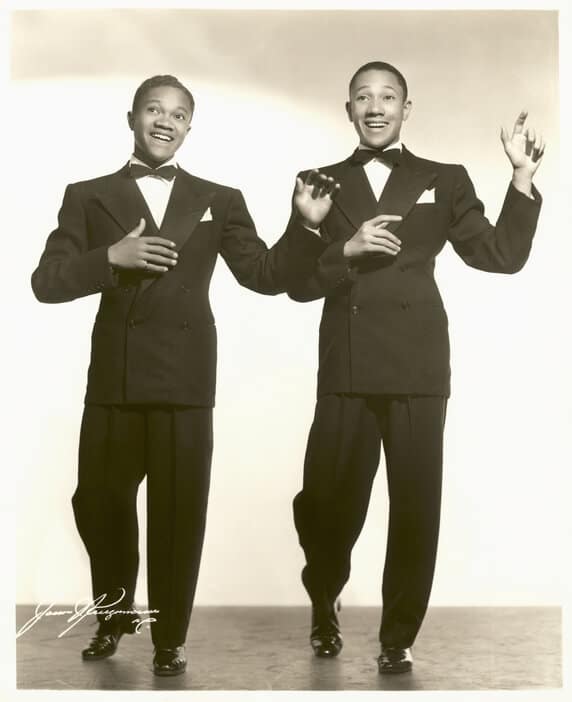
Sons of vaudevillians, Fayard and Harold grew up in Philadelphia. As children, they watched from the wings of the theaters where their parents worked, and learned much from the leading black vaudeville artists of the 1920s.
They drew especially on Bill Robinson’s precision, Duke Ellington and Jack Wiggins’ style and acts like the tumbling Crackerjacks. Fayard insisted that Leonard Reed, the choreographer and producer who started as a tap-Charleston dancer, was his greatest influence. (Source)
His mother, Viola Harden, played the piano, and his father, Ulysses D. Nicholas, played drums at the Standard Theater in Philadelphia (the couple billed as “The Nicholas Collegians”) and it is there that Fayard taught himself to dance by sitting on the bandstand “next to my dad’s drums” and nightly watching dance acts of the time such as Buck and Bubbles, the Step Brothers and the Berry Brothers. “I thought, ‘They’re having fun up there, I’d like to do something like that,” he recalled.
In 1920 his sister Dorothy was born, and the following year his brother Harold. Fayard taught both of them to dance, devised an act, and showed it to their father whom he recalled made only three comments – “I like the way you use your hands”, “Don’t look at your feet”, and “Do look at the audience”. The act débuted in Philadelphia in 1927 as “The Nicholas Kids”, then toured with their parents, though Dorothy soon dropped out because she never cared for show business. (source)
When Owney Madden, the gangster who owned the famed Cotton Club (which featured black performers, though no African-Americans were allowed to be in the audience) saw their act in 1932, he arranged for them to audition for Duke Ellington. Ellington put them into the show and they continued to perform at the club when Cab Calloway replaced Ellington. At 18 and 11, respectively, Fayard and Harold became the featured act at the Cotton Club.
“We were kids,” said Fayard, “but we danced like men.”
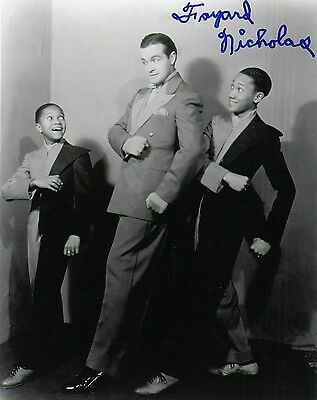
Their parents had now given up performing in order to manage their sons’ careers. The brothers made their screen début in a Vitaphone short, Pie Pie Blackbird (1932), with Eubie Blake, and they made their feature film début after Sam Goldwyn saw their act and persuaded United Artists to give them a contract and roles in his production, Kid Millions (1934), in which they took part in minstrel sequences and performed the numbers “Minstrel Man” and “Mandy” (warning: there is blackface in this clip). Fayard, as usual, did the choreography for himself and Harold, describing the film’s dance director, Seymour Felix, as “like Busby Berkeley – he didn’t dance but he had ideas”.
They later were snapped up for The Big Broadcast of 1936, immediately followed by an intensive period of stage performances. It was at that time that they made their Broadway début in The Ziegfeld Follies of 1936 with Fannie Brice and Josephine Baker.
The brothers earned fame with a unique style of rhythm tap that blended “masterful jazz steps with daredevil athletic moves and an elegance of motion worthy of ballet”. They appeared in the Ziegfeld Follies on Broadway and in London they worked with jazz choreographer Buddy Bradley. The performances led them to a career in film. Nicholas appeared in over 60 films, including the 1943 musical Stormy Weather with their signature staircase dance. (source)
It was their tour of England with a production of “Blackbirds” that gave the Nicholas Brothers an opportunity to see and appreciate several of the great European Ballet companies. Thoroughly impressed, they absorbed much of the techniques and tried to incorporate certain ballet movements into their jazz dance patterns. In a short film that they made in London during this period, “Calling All Stars”, (1937), this interpretative style is quite noticeable and intriguing to observe.
The impression that the Nicholas Brothers made upon Balanchine, the choreographer, was so unforgettable that he invited them to appear in the Rogers and Hart musical, “Babes in Arms”, for the 1937 Broadway season.

They considered this a high point in their career because Balanchine was a ballet master and they learned many new stunts. Because of their skill, many people assumed that the Nicholas Brothers were trained ballet dancers.
In 1938, the Cotton Club – by then in midtown Manhattan – beckoned again, and it was during this engagement that they competed with the Berry Brothers, a black acrobatic dance trio, in a legendary formation, a sort of dance-fight for supremacy. The event is a part of show business history.
According to the New York Times:
Despite the racial hurdles facing them as black performers, they went on to Broadway, then Hollywood. Astaire once told the brothers that the acrobatic elegance and synchronicity of the “Jumpin’ Jive” dance sequence in “Stormy Weather” (1943) made it the greatest movie-musical number he had ever seen. In that number, the brothers tap across music stands in an orchestra with the fearless exuberance of children stone-hopping across a pond. In the finale, they leap-frog seamlessly down a sweeping staircase.
Despite his fame and success, Fayard’s career was interrupted from 1943 to 1944 when he served in the U.S. Army during World War II. (source) Fortunately for the world, he returned to performing.
According to Nicholas Brother’s website
The nightclub and concert circuit took over their career, and there were long tours of South America, Africa and Europe. In 1948 they gave a royal command performance for the King of England at the London Palladium.
The NYT article continued:
Their polished urbanity and classic good looks made the Nicholas Brothers film stars despite the celluloid segregation that relegated them to non-speaking parts and dance sequences that could be easily cut for racially squeamish audiences in the South. They finally danced with a white star, Gene Kelly, in their last film together,“The Pirate (1948)”
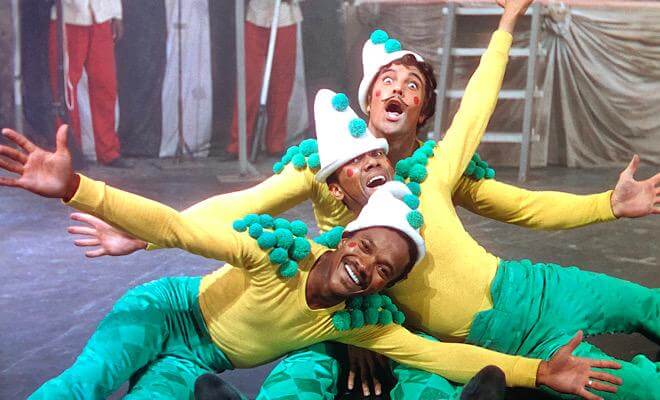
According to the Independent,
The pair’s final film together was The Pirate (1948), for which they were especially requested by Gene Kelly, who danced with them to the number “Be a Clown”. However, Fayard was disappointed that for the first time in movies he had no hand in the choreography, which was done by Kelly and Robert Alton.
The Nicholas Brother’s danced for nine different presidents of the United States.
 “My brother and I used our whole bodies, our hands, our personalities, and everything,” Fayard Nicholas told the Los Angeles television station KCET in 2005. “We tried to make it classic. We called our type of dancing classical tap and we just hoped the audience liked it.”
“My brother and I used our whole bodies, our hands, our personalities, and everything,” Fayard Nicholas told the Los Angeles television station KCET in 2005. “We tried to make it classic. We called our type of dancing classical tap and we just hoped the audience liked it.”
Severe arthritis curtailed Fayard’s ability to perform, but in 1981 long-overdue recognition of the brothers began when they were given a film tribute at the Academy Awards show. In 1991 they received the Kennedy Center Honors, the US’s highest award for artistic achievement, and in 2000 were given a sold-out tribute at Carnegie Hall with Lena Horne and Savion Glover among those performing in their honor.
Until his stroke, he tap-danced and spoke at dance festivals around the world. His two granddaughters, calling themselves the Nicholas Sisters, would perform his old steps. The cause was pneumonia and other complications of a stroke he suffered in November, his son Tony said. (source)
Check out some of his final interviews.